STE Highlights, June 2021
Awards and Recognition
Capability Enhancement
ARMY – LANL – NNSS collaboration develops pRad technique to visualize electromagnetic fields
Awards and Recognition
Saryu Fensin joins APR early career editorial board
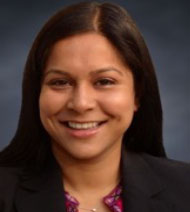
Saryu Fensin of the Materials Science in Radiation and Dynamics Extremes Group (MST-8) has joined the Early Career Editorial Advisory Board of Applied Physics Reviews. Her three-year term began in January.
Fensin, who earned her PhD in materials science and engineering from the University of California, Davis, is a member of MST-8’s Dynamic and Quasi-Static Loading (experimental) team.
Andrew Bartlow selected to attend the 70th Lindau Nobel Laureate Meeting
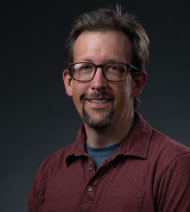
Andrew Bartlow, a postdoc in the Biosecurity and Public Health Group (B-10), was selected by the University of California to attend the 70th Lindau Nobel Laureate Meeting in Germany.
The Lindau Meeting occurs once every year during which around 30-40 Nobel Laureates convene in Lindau to meet the next generation of leading scientist, including 600 undergraduates, PhD students, and post-doc researchers from all over the world. Young scientists have to be nominated by academic partners in order to be able to apply for participation.
An overarching theme for Bartlow as a scientist is the interconnectedness of living systems and how this translates into interdisciplinary research about such systems. His research ranges from studying the interactions between acorns and seed dispersers (such as birds and small mammals) to how biological communities can be used as signatures of environmental change to the biosurveillance of infectious diseases around the globe.
In his Lindau meeting application letter, Bartlow emphasized the value of interaction among scientists. He proposed that there is much to learn by connecting with scientists who span generations, disciplines, and backgrounds—and Bartlow hopes to apply these lessons to his future goals of increasing scientific literacy among scientists and the public through mentoring and communication.
Piotr Zelenay named 2021 International Society of Electrochemistry Fellow
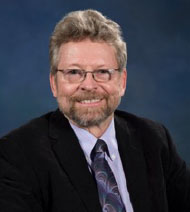
Piotr Zelenay of the Materials Synthesis and Integrated Devices group (MPA-11) has been appointed an International Society of Electrochemistry (ISE) Fellow in recognition of his outstanding scientific record and contributions to electrochemical science.
Founded in 1949, the International Society of Electrochemistry has 3,000 members from more than 70 countries. Fellowship is limited to approximately 5% of the society’s active membership.
Zelenay’s research focuses primarily on fundamental and applied aspects of polymer electrolyte fuel cell science and technology, electrocatalysis, and electrode kinetics.
A LANL and Electrochemical Society fellow, Zelenay is the recipient of numerous awards for his research achievements. These include a 2020 DOE Hydrogen and Fuel Cells Program merit review award for his leadership in the ElectroCat Consortium (his second such DOE merit award), a 2017 R&D 100 Award for his electrocatalysis research, the 2014 Los Alamos National Laboratory Fellows Prize for Research for his work in nonprecious metal electrocatalysts, and the 2012 Research Award from the Energy Technology Division of The Electrochemical Society.
Bioscience
Biodiversity is a harbinger of ecosystem health
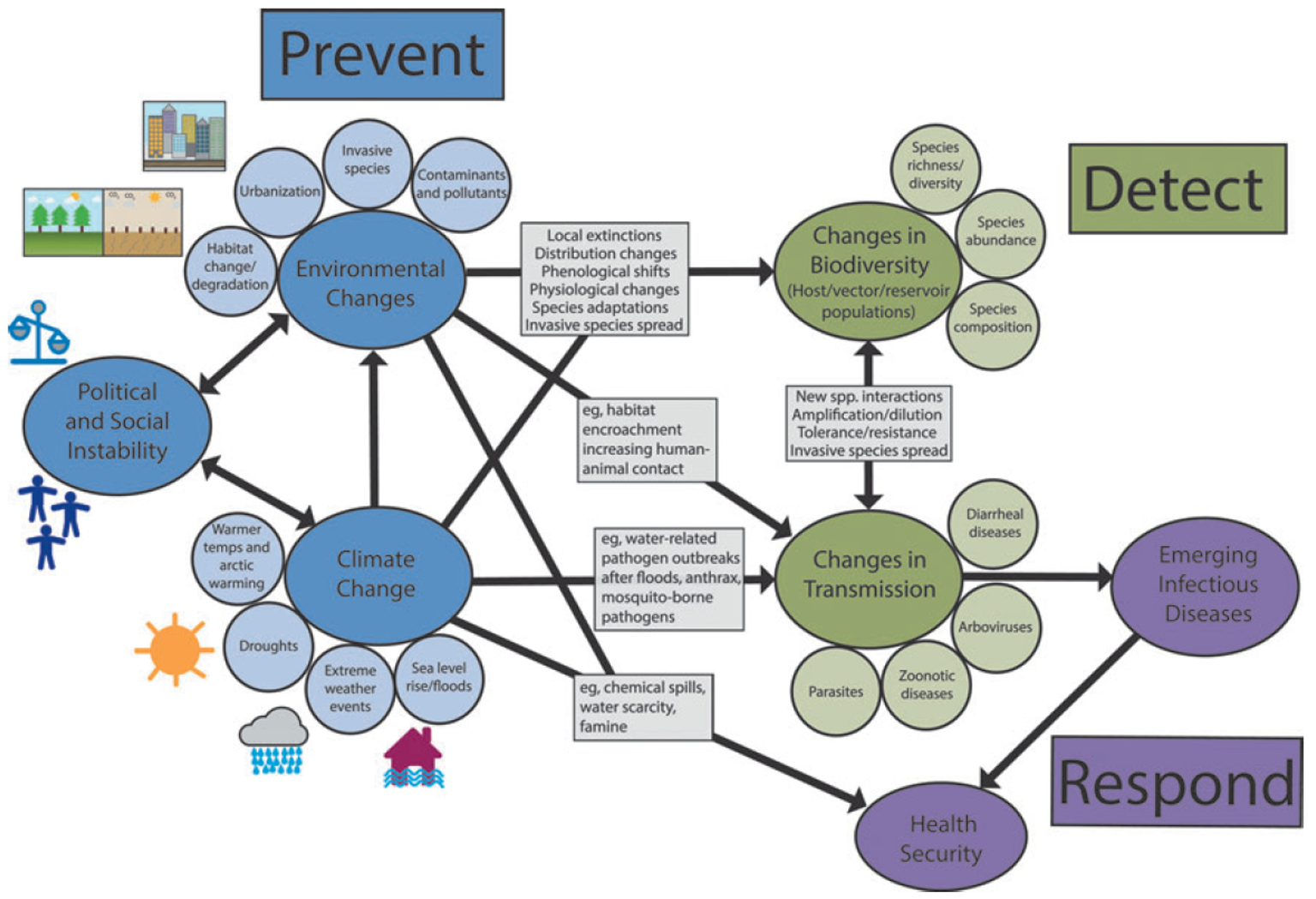
Figure 1 from the publication in Health Security. How biodiversity and environmental change affect health security. This diagram reflects net expected outcomes. In some cases (eg, unsuitable host range), risk will decrease but overall risk is expected to increase.
The diversity of organisms is critical for the health of all living things on the planet. In a commentary in the journal Health Security, Los Alamos’s Andrew Bartlow and Jeanne Fair, of the Biosecurity and Public Health group (B-10), along with policy advisors at the EcoHealth Alliance, explain how changes in biodiversity—from genes to species to ecosystems and ecological complexes—can lead to the emergence of infectious diseases and possibly even new pandemics.
The authors contend that when assessing the risk of infectious disease, it is important not only to address links between human and animal health, but it also is critical to consider impacts from changes to wildlife and the environment.
The authors provide examples of how human activities are altering ecosystems resulting in impacts to species diversity. For instance, increased deforestation and urbanization actively reduce the size and quality of animal habitats, bringing humans and animals physically closer together. Humans may also introduce invasive plant species to habitats, causing additional change.
Overall, any changes to habitats can make it more difficult for some animals, plants, and even microorganisms to survive—thus reducing biodiversity. Large changes to the food chain are sometimes obvious, but less visible changes can happen to the “services” in the ecosystem such as decomposition, soil productivity, pollination, and carbon sequestration.
Understanding how changes in biodiversity impact the incidence of infectious disease emergence is key and should influence mitigation strategies to promote global health security. The authors explain how changes in host biodiversity can either dilute or amplify the transmission of disease. Dilution occurs when a pathogen is able to infect many species, but only some are competent hosts and contribute to transmission. Any host that is not competent—an incompetent or “dead end host”—essentially stops the pathogen from spreading further, thus diluting its impact. If biodiversity is diminished, the chances for dilution are also reduced, resulting in greater disease risk. Alternatively, an increase in biodiversity is known to increase the risk of some diseases through the amplification effect, highlighting the challenge of making predictions about disease risk following changes in biodiversity.
“Some diseases may show different responses to biodiversity loss depending on local environmental conditions,” said Bartlow. “This is why it is critical that we increase efforts to incorporate aspects of biodiversity into disease prevention and detection.”
Multiple factors create opportunities for disease spread and possibly even new pandemics. For instance, if species are stressed due to changes in their habitat, they may be more susceptible to diseases, and a disease might spread more easily because of a lack of diversity in the ecosystem. Finally, if diseased animals are living in closer proximity to urban centers, there may be increased opportunities for pathogens to spill over into humans. But there are many more complicated variables to consider—for instance, climate changes can lead to mosquitos (vectors of diseases such as Dengue fever, West Nile virus, and Zika virus) thriving in new locations, or to further destruction of habitats due to drought or extreme weather events.
In conclusion, the authors stress the value of a more holistic approach. “In addition to understanding and mitigating disease emergence and spread, we need to expand our thinking beyond the current emphasized scope of zoonotic, vector borne, and antimicrobial-resistant threats to consider the role of climate and other environmental risks in health and security (eg, via food and nutrition supply) at different scales.”
Funding and mission
This research was funded by LDRD, and a Director’s Funded Postdoc Fellowship. The work supports the Laboratory’s Global Security mission area and the Science of Signatures capability pillar.
Reference: Andrew W. Bartlow, Catherine Machalaba, William B. Karesh, and Jeanne M. Fair. Biodiversity and Global Health: Intersection of Health, Security, and the Environment. Health Security. Volume 19, Number 2, 2021 http://doi.org/10.1089/hs.2020.0112
Capability Enhancement
ARMY – LANL – NNSS collaboration develops pRad technique to visualize electromagnetic fields

Multi-probe assessment of an electrically energized and burst wire including pRad-EMV, X-ray radiography, and optical photography. The dark copper-colored rod superimposed in the center of the figure represents the position of a 1.6 mm diameter copper rod prior to electrical impulse. Utilization of multiple diagnostics simultaneously allowed for temporal assessment of the material states and the magnetic field structure (correlated with electrical conduction paths) throughout the bursting process.
Predicting how electrical current flows through complex, multi-material environments, including dynamic material failure and fragmentation is difficult. Complications of failure dynamics including instability growth and new surface generation combine with turbulent mixing and material phase transformations to produce continually varying conduction properties. The capability to predict how current flows through these harsh environments, however, is crucial to the development of advanced D.o.D. protection and lethality concepts, and appeals to a broad spectrum pulsed-power/high-potential electrical applications.
To advance on the electrical flow prediction capability, scientists from DEVCOM Army Research Laboratory (ARL), Los Alamos National Laboratory, and Nevada National Security Site (NNSS) have developed an experimental campaign to explore using LANL’s lens-based Proton Radiography Facility (pRad) to radiograph targets that purposefully include electromagnetic fields.
The result led to development of a new capability allowing for visualization of magnetic fields, in situ, during dynamic experiments. The capability is similar to that of proton deflectometry, but benefits by using the accelerator-generated 800-MeV protons and removal of the detector system from the potentially harsh local target environment. The technique provides the capability to supply vital insight to theory development and code validation of electrical flow by allowing for visualization of the electromagnetic states during the conduction process.
To demonstrate the technique’s usefulness, a series of multi-probe experiments were conducted in which 1.6-mm-diameter copper rods were electrically energized and burst using a capacitive drive. The experiments paired the pRad electromagnetic visualization (pRad-EMV) technique with multi-pulse flash x-ray radiography and optical photography to assess the dynamic electrical and material states, simultaneously. After validating the pRad-EMV technique using targets that produced known magnetic fields of closed-form solution (i.e., electrically energized straight rod), the system was used to inspect multiple aspects of dynamically changing electrically burst rods. The experiments inspected magnetic fields of magnitudes up to ~40 tesla generated by currents of up to ~150 kA propagating through fields containing conducting and insulating particles, gasses, and plasmas. The results are currently being analyzed and will be used to assess theory and validate magnetohydrodynamics models.
DEVCOM ARL researchers include: M.B. Zellner, W.C. Uhlig, P.R. Berning, and R.L. Doney III. LANL researchers include: L.P. Neukirch, M.S. Freeman, J.T. Bradley III, H.J. Gaus III, L.N. Merrill, C.H. Wilde, W.Z. Meijer. NNSS researchers include: D. Phillips, D. Guerrero, and L. Fegenbush
References:
A. J. Mackinnon, P. K. Patel, R. P. Town, M. J. Edwards, T. Phillips, S. C. Lerner, D. W. Price, D. Hicks, M. H. Key, S. Hatchett, and S. C. Wilks, “Proton radiography as an electromagnetic field and density perturbation diagnostic,” Review of Scientific Instruments, 75, 10, 10.1063/1.1788893.
F. Beg and M. Weis, “Assessment of proton deflectometry for exploding wire experiments,” DE-‐SC-‐0001992 final report, Sept. 2013.
Computer, Computational and Statistical Sciences
NASA selects U. Michigan-LANL proposal for a rocket experiment to test techniques that could enable the operation of high-power electron accelerators in space
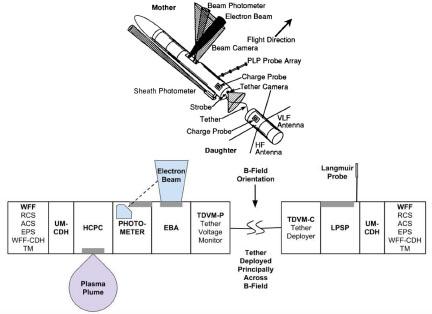
Schematics of B-SPICE.
In March 2021, NASA has selected a joint proposal by the University of Michigan (mission PI, Prof. Brian Gilchrist) and LANL (science PI, Gian Luca Delzanno) to test a new spacecraft-charging mitigation scheme in space, on a rocket experiment in the ionosphere. Launch is expected in 2023.
The experiment is called the Beam Spacecraft Plasma Interaction and Charging Experiment or B-SPICE. (See the schematics in adjacent figure.) A 150-mA, 1-keV electron beam will be used to charge the rocket to 1 kV, i.e. to levels that will not allow further emission of the electron beam. The spacecraft-charging mitigation scheme based on the plasma contactor technology will then be used to maintain the charging of the rocket to levels substantially lower than 1 kV and allow sustained beam emission. Suitable instrumentation will be used to characterize the local plasma environment and the charging of the rocket. Modelling in support of the experiment will be performed in T-5, with the goal of testing our understanding of spacecraft-charging mitigation in space as well as further validating the theoretical and computational models developed at LANL.
B-SPICE is part of a broader LANL strategy to develop electron accelerators for space applications, which started over two decades ago when LANL began pursuing an electron-beam space mission concept to study the coupling between magnetosphere and ionosphere and the causes of the spectacular auroras seen at high latitudes. This mission concept is called CONNection EXplorer (CONNEX).
Although there remain important differences between a rocket experiment in the ionosphere and a magnetosphere-ionosphere coupling experiment in the magnetosphere, B-SPICE is a critical development that will take LANL and its partners one step closer to CONNEX.

A high-power electron beam emitted by a spacecraft travels along the magnetic field line to its footpoint in the ionosphere. Distant regions of near-Earth space could be connected unambiguously with this technique, establishing causality and solving long-standing questions in magnetosphere-ionosphere coupling physics.
The scientific problem. The magnetosphere is the region of space around the Earth dominated by the Earth’s magnetic field. The magnetic field in the magnetosphere connects to the ionosphere, which is the upper layer of the Earth’s atmosphere (between 60 and 1000 km from the surface) ionized by solar and cosmic radiation. Magnetosphere-ionosphere (MI) connections are determined by the magnetic field: as charged particles move much more easily along the magnetic field than across it, geomagnetic activity generated in the magnetosphere can be transmitted to the ionosphere. For instance, as geomagnetic storms and substorms (analogue of atmospheric storms) develop in the magnetosphere, charged particles are energized in the magnetosphere and subsequently travel along the magnetic field to the ionosphere, where they produce spectacular visual auroras by interaction with the local atmospheric gas. Indeed, auroras are a manifestation of processes operating in the magnetosphere during geomagnetic storms.
Auroras have generated wonder and fascination for centuries. Despite much progress, however, the actual magnetospheric processes related to the aurora have been hard to pin down. We have extensive ground-based measurements that characterize the state of the auroral ionosphere and we have measurements from magnetospheric spacecraft that can characterize the local state of the magnetosphere. Unfortunately, in most cases, we cannot link ionospheric and magnetospheric measurements unambiguously because we do not know the magnetic field morphology with enough accuracy. This is known as the magnetic-field-mapping problem. This problem hinders progress in magnetospheric research and many of the fundamental connections, essential physics, and drivers of the coupling between ionosphere and magnetosphere remain poorly understood.
The solution. An electron beam fired from a magnetospheric spacecraft and detectable optically or by radar in the atmosphere is the only definitive solution to the magnetic-field-mapping problem. The beam acts as a ‘tracer’ of the magnetic field lines, as can be seen schematically in the adjacent figure. This is the idea behind CONNEX. Electron-beam mapping could help bring closure on many fundamental open questions in MI coupling physics such as
(1) what magnetospheric mechanisms produce the aurora in the upper atmosphere?
(2) how does the aurora impact the magnetospheric system?
(3) how can we use ionospheric observations as a window to observe the global operation of the magnetosphere?
(4) what-drives-what between the ionosphere and magnetosphere, when, and where?
In general, there are several magnetospheric phenomena and boundaries which could be connected with their ionospheric counterpart using electron-beam mapping and there are several ionospheric phenomena for which the magnetospheric source could be identified.
The major technical challenge. LANL has been in pursuit of CONNEX for the past two decades. When operating a high-power electron beam in the outer magnetosphere, the major challenge is the potentially catastrophic charging of the spacecraft. (Spacecraft charging refers to the accumulation of charge on the spacecraft due to absorption of plasma particles from the environment and the emission of charge, either due to natural processes such as photoemission or secondary electron emission or man-made sources such as electron- and ion-beams.) This is because the outer magnetosphere is characterized by an extremely low-density plasma and so it can only provide low return currents that cannot fully compensate for the beam current. To be more concrete, a detectable beam spot in the atmosphere in the presence of aurora requires ~10 kW of power. This could be realized by a 10 keV beam with 1 A of current or by a 1 MeV beam with 10 mA of current. These currents are much higher than the thermal current from the environment, which is tens of µA for typical parameters at geosynchronous orbit. Simple spacecraft charging estimates indicate that the spacecraft would charge to ~100 kV for the 10 mA beam and ~10 MV for the 1 A beam. Both values are too high for safe spacecraft operations. Indeed, fear of catastrophic spacecraft charging is the main reason why this idea has never been realized in practice and remains identified as an outstanding emerging-technology problem in the most recent National Academies Decadal Survey of Solar and Space Physics.
Work by LANL and its partners. In order to enable the use of high-power electron beams in low-density plasma magnetospheric environments, two directions are being pursued by LANL and its partners. The first is the development of a new generation of compact, radio-frequency, relativistic electron accelerators that can achieve the needed power but operate with lower current, as discussed above. The concept is under development, championed by LANL AOT division. The second direction is the development of a spacecraft-charging mitigation scheme. Recent modeling work in the Applied Mathematics and Plasma Physics group (T-5) at LANL determined that the so-called plasma contactor technology is a viable candidate to achieve substantial spacecraft-charging mitigation. The idea is to emit a high-density, charge-neutral plasma in concert with the electron beam, to alter the collection of currents by the spacecraft and enable both the emission of the beam and safe spacecraft operation. The idea has been validated with recent laboratory experiments at the University of Michigan. Both the LANL modeling and Michigan experiments were supported by the LDRD-ER program.
Technical Contact: Gian Luca Delzanno
LANSCE
DICER instrument at LANSCE used to help design world’s largest cryogenic neutrino detector
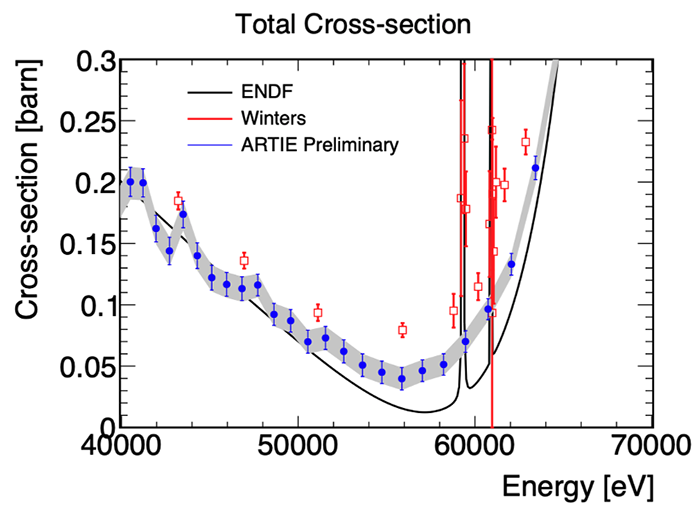
Preliminary results from ARTIE showing neutron cross section in argon as a function of energy.
Leveraging the capabilities of the Los Alamos Neutron Science Center (LANSCE) accelerator, a team of LANL scientists and collaborators successfully demonstrated that calibrations planned for the Deep Underground Neutrino Experiment (DUNE) can be performed as required.
The DUNE project, involving 1,000 scientists from more than 30 countries, will use neutrinos and their antimatter counterparts to understand why the universe is dominated by matter. A critical part of designing DUNE, the world’s largest liquid argon particle detector, is ensuring its central active volume can be calibrated for energy response and efficiency.

Sofia Andringa and Leon Picard aligning the ART1E target in the DICER target chamber.
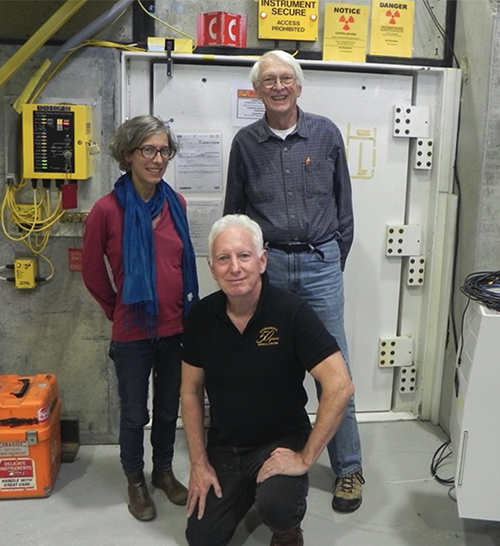
From left: Sofia Andringa, Robert Svoboda, and John Ullman near the DICER target chamber.
However, that 70-kiloton liquid argon detector and its location 1.5 miles underground—in an abandoned South Dakota gold mine—makes DUNE’s accurate calibration complicated, according to Sowjanya Gollapinni of Nuclear and Particle Physics and Applications (P-3), who co-leads the DUNE Calibration and Cryogenic Instrumentation consortium.
To address these calibration challenges, University of California, Davis and LANL scientists plan to inject low-energy neutrons into DUNE’s central region using a deuterium-deuterium neutron generator. This is an attractive method because the generator could potentially be placed outside the cryostat, avoiding the need to operate in such an extreme environment that also has stringent cleanliness requirements.
“This is a very novel technique and is the first time it’s being applied to a large neutrino detector,” said Gollapinni.
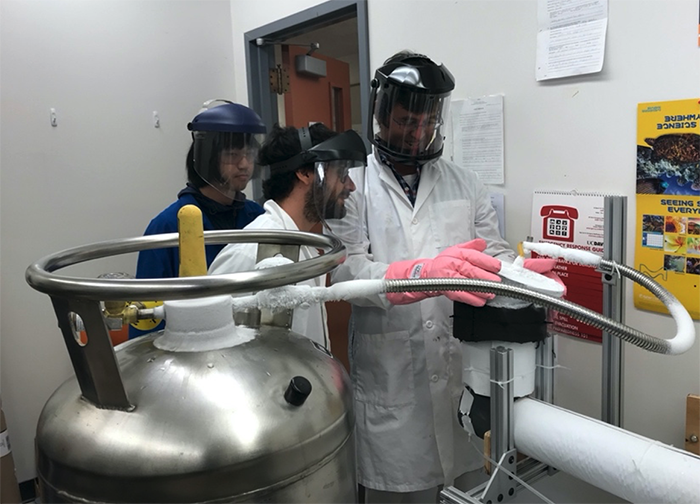
From left: Junying Huang, Luca Pagani, and Mike Mulhearn test the cryogenic ARTIE target performance at UC Davis.
To test this technique, DUNE scientists from UC Davis, led by Bob Svoboda, and the University of Lisbon, led by Sophia Andringa, joined John Ullmann and Paul Koehler (P-3) to design a large liquid argon sample for DICER, a device for indirect capture of radionuclides being developed at LANSCE. The team (which also included UC Davis professor Mike Mulhearn; postdoctoral researchers Luca Pagani, Leon Pickard, and Jingbo Wang; and graduate students Yash Bezawada, Tyler Erjavec, Julie He, and Junying Huang) successfully designed and tested a 168-cm-long cryogenic target that would fit in DICER. Pagani and Pickard are Nuclear Science and Security Consortium (NSSC) postdoctoral fellows and He and Erjavec are NSSC-supported students.
The target, or Argon Resonant Transport Interaction Experiment (ARTIE), was designed and fabricated at UC Davis and installed in DICER last year. Its measurements—the ratio of neutrons transmitted with the sample full of liquid argon to that of an empty sample—revealed neutron transport through a known amount of liquid argon across a wide range of energies.
Preliminary results, analyzed by UC Davis, South Dakota Mines, and Lisbon, show that the transport of neutrons through liquid argon is sufficient for DUNE purposes.
“ARTIE is a critical milestone to finalize the DUNE calibration program and is also an excellent example of a dedicated, small, international collaboration using a LANSCE instrument being developed for applied measurements and producing high impact physics results. DUNE is eagerly looking forward to the final results and publication,” said Gollapinni.
Funding and Mission
Initial funding for DICER came from Science Campaign 4. The students and postdocs involved in running the experiment are supported through National Security Science Consortium (NSSC) fellowships. DICER supports the Nuclear and Particle Futures capability pillar and the Lab's Nuclear Deterrence mission.
References
E. Koehler, J. Ullmann, A. Couture, and S. Mosby, in Compound-Nuclear Reactions, Springer Proceedings in Physics 254, doi.org/10.1007/978-3-030-58082-7_22; lansce.lanl.gov/facilities/lujan/instruments/fp-13/index.php.
The ARTIE Collaboration, “Preliminary Results from ARTIE”, September 2020. svoboda.ucdavis.edu/files/3416/0490/2087/APSWest_2020_ARTIE_compressed.pdf
Materials Science and Technology
From atoms to pins: Leveraging multiscale simulations to predict fission gas release from advanced nuclear fuel
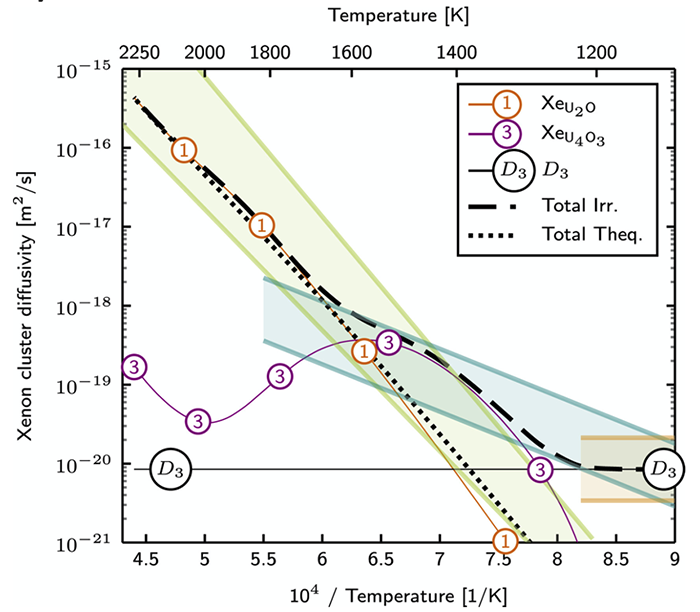
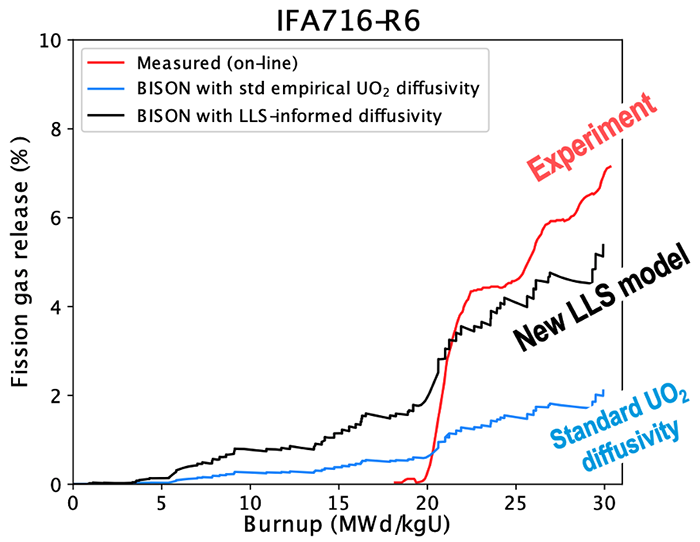
Top image: Cluster dynamics simulations of fission gas diffusivity in traditional UO2 (lines) with comparison to experiment (colored bands), and bottom image, demonstration of the new model for fission gas diffusivity in doped UO2 for Bison simulations of fission gas release during a Halden Reactor Project test.
To enable useful predictions of nuclear fuel behavior beyond traditional operating envelopes, a mechanistic model based on fundamental phenomena is required. While a multiscale approach towards these problems—and in particular fission gas diffusion—is typically required, atomic scale simulations often have trouble providing quantitative agreement with experimental measurements.
By integrating a wealth of DFT data developed at LANL with a newly published LANL cluster dynamics code “Centipede,” the full spectrum of fission gas behavior across all expected temperatures and dose rates can now be mechanistically computed for the first time in UO2 (see top image). This code predicts the diffusivities of dozens of Xe-containing defects in UO2, and most importantly the dominant large xenon clusters that drive irradiation enhanced diffusion. A critical aspect of the new cluster dynamics model is the use of the oxygen potential of the fuel as an input.
Unlike traditional UO2, there is limited experimental data of Xe diffusivity in Cr2O3-doped UO2, posing a challenge to the development of new nuclear fuel performance modeling capability. To enable application of Centipede to doped UO2, it was first established, using thermodynamics calculations, that additions of Cr2O3 to UO2 results in a two-phase Cr-Cr2O3 equilibrium that controls the oxygen potential. Implementation of this oxygen potential in Centipede shifts the stability of all point defects and clusters in the system, resulting in an enhancement in Xe diffusivity.
Los Alamos researchers in collaboration with partners at Idaho National Laboratory and the Massachusetts Institute of Technology, used fuel performance simulations of fission gas release which revealed that by including both enhanced diffusivity—as predicted by lower length scale (LLS) simulations—and the large grains exhibited by Cr2O3-doped UO2, a much-improved agreement with Halden reactor test results is obtained. This work was recently published in two articles in the Journal of Nuclear Materials.
Funding and Mission
This work was funded by the DOE Office of Nuclear Energy Nuclear Energy Advanced Modeling and Simulation (NEAMS) program. The research supports the Lab's Energy Security mission and the Materials for the Future capability pillar.
References
Traditional UO2: C. Matthews (Materials Science in Radiation and Dynamics Extremes, MST-8), R. Perriot (Physics and Chemistry of Materials, T-1), M.W.D. Cooper, C. R. Stanek, and D.A, Andersson (all MST-8), “Cluster dynamics simulation of xenon diffusion during irradiation in UO2,” Journal of Nuclear Materials 540 152326 (2020). https://doi.org/10.1016/j.jnucmat.2020.152326
Doped UO2: M.W.D. Cooper (MST-8), G. Pastore (INL), Y. Che (MIT), C. Matthews (MST-8), A. Forslund (KTH Royal Institute of Technology, Sweden), C.R. Stanek (MST-8), K. Shivan (MIT), T. Tverberg (Institute for Energy Technology, Norway), K.A. Gamble (INL), B. Mays (Framatome Inc.), and D.A. Andersson (MST-8), “Fission gas diffusion and release for Cr2O3-doped UO2: from the atomic to the engineering scale,” Journal of Nuclear Materials 545 152590 (2021). https://doi.org/10.1016/j.jnucmat.2020.152590
Imaging breakthrough of plastic bonded explosives
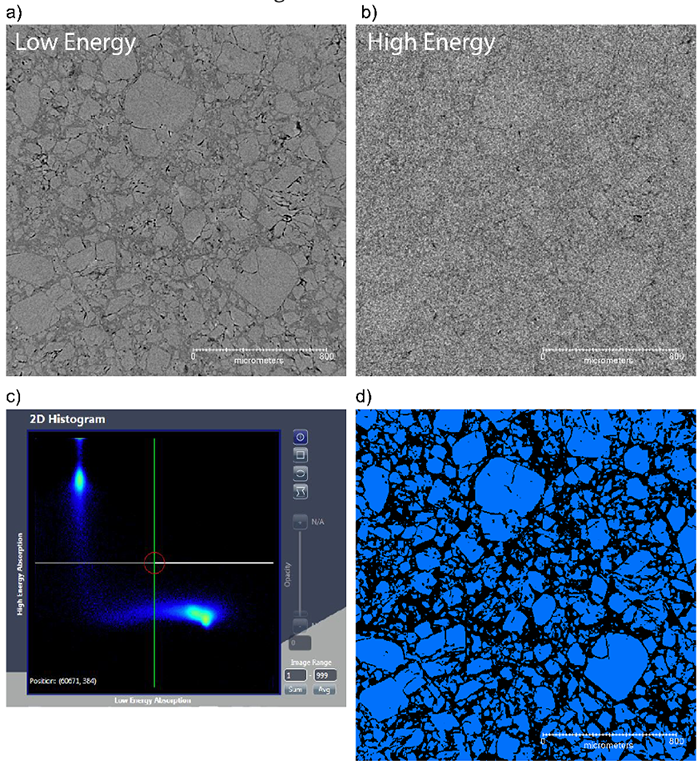
Figure 1: A single reconstructed slice from the dual energy images low (a) and high (b). Correlation plot of the absorption values (c) and segmented image of the crystals (d) by the selection of one of the correlation “hot-spots.”
A team of researchers in the Engineered Materials group (MST-7) and the High Explosives Science and Technology group (Q-5) have been working to develop new 3D x-ray imaging techniques and have created a library of 3D images of 10 different high explosive formulations. The new technique advances the characterization of the microstructure of high explosives (HEs), which can provide critical information for future modeling and simulation efforts.
Plastic-bonded explosives (PBX) are comprised of an explosive crystal (e.g., HMX, TATB, or RDX) mixed into a polymer binder (e.g., Estane, HTPB, Kel-F, or viton A). Because the composition of both of these materials is primarily carbon, hydrogen, and oxygen, and the nearly identical mass density between the materials, the x-ray contrast within these materials is often negligible.
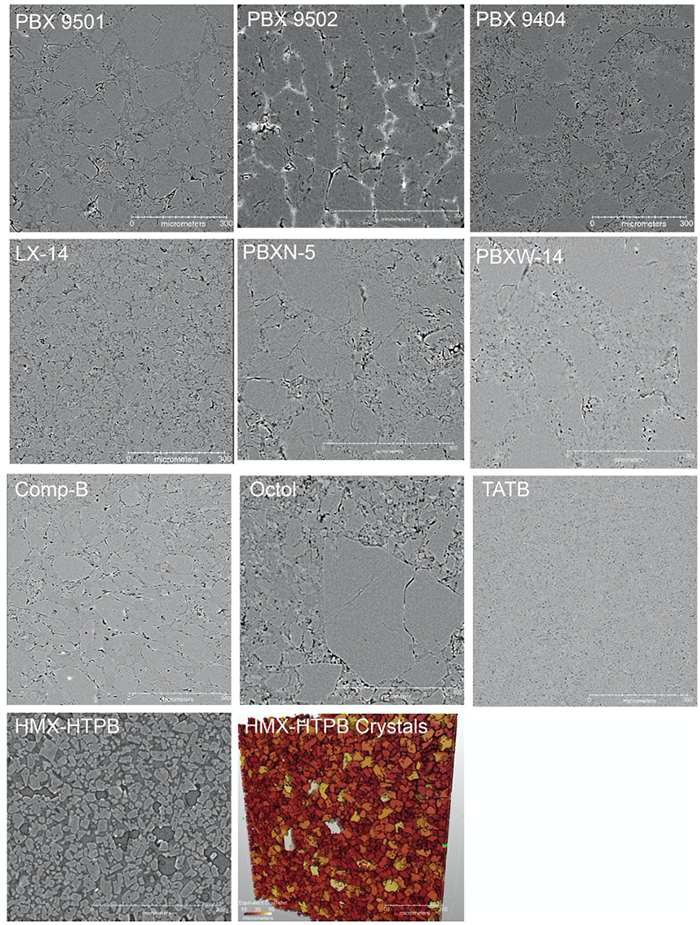
Figure 2: Individual reconstructed slices for each of the ten formulations and a 3D rendering of the HMX-HTPB. Crystals are colored by their size.
Due to these issues, segmentation and image analysis (i.e., differentiating between the crystals and the binder and then measuring the crystal distributions) is nearly impossible. In work recently published in Materials, the team describe use of a dual-energy x-ray imaging technique to better differentiate between the HE crystals and the surrounding binder. This technique collects a low x-ray energy 3D image as well as a high x-ray energy 3D image. The two images rely on the difference in absorption processes between the photoelectric effect at low energies and Compton scattering at higher energies. The images are then combined and a correlation plot between them is created. From this, correlation “hot-spots” are used to segment the material and differentiate between the crystals, binders, and voids. Figure 1 shows the low (a) and high (b) energy images, correlation plot (c), and a segmented image (d) of the crystals within a PBX 9501 specimen.
Additionally, the team of researchers has also been working to create a library of high-resolution 3D tomographic images of the ten most commonly LANL-studied HE materials. These include: HMX-HTPB, PBX 9501, PBX 9502, PBX 9404, LX-14, PBXN-5, PBXW-14, Composition B, Octol, and TATB. Each of these materials were imaged with ~0.8 µm voxel size. Figure 2 shows a single reconstructed slice of the ~2000 collected to make the 3D data set for these materials as well as a 3D rendering of the individual HMX crystals within the HMX-HTPB formulation. These high-resolution 3D images of the PBX microstructure are available to researchers. Most were also imaged with the afore-mentioned dual-energy modality for modeling or other uses.
The team, comprised of MST-7: Brian M. Patterson, Lindsey Kuettner; and Q-5: John D. Yeager, Amanda L. Duque, and Larry G. Hill, was supported by Delivery Environments (Antranik Siranosian) and Campaign 2 (Dana Dattelbaum).
Funding and mission
Delivery Environments (LANL Program Manager Antranik Siranosian) and Campaign 2 (LANL Program Manager Dana Dattelbaum) funded this work. The research supports the Lab's Nuclear Deterrence mission and the Materials for the Future capability pillar.Reference
“Microcomputed x-Ray tomographic imaging and image processing for microstructural characterization of explosives,” Materials 13 20 (2020).








